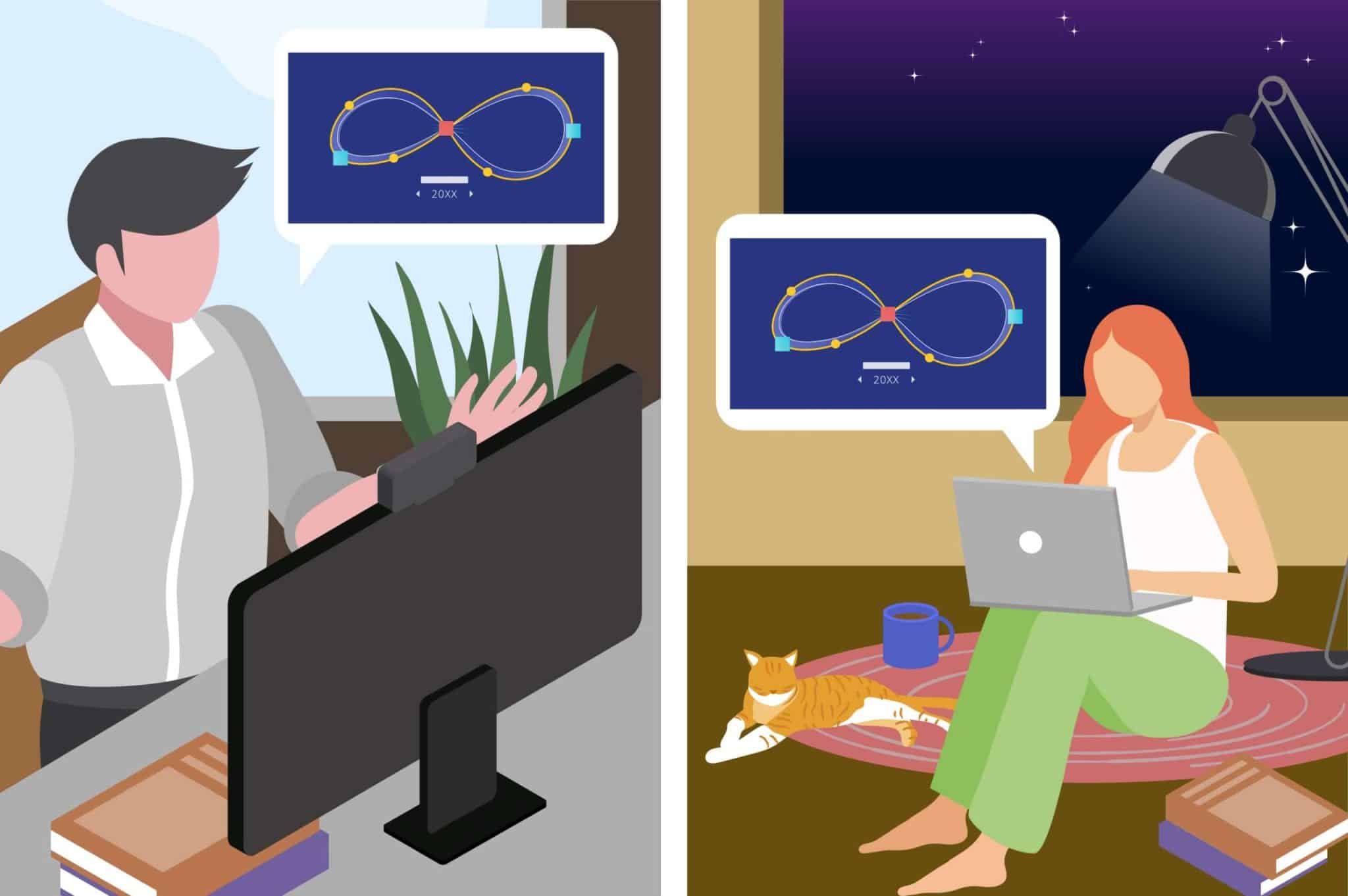Is it possible to gain knowledge from any corner of the world just by sitting at home? Yes, E-learning comes into the limelight. While beginning the e-learning journey, learners might undergo challenges in choosing the e-learning platform.
What should be considered to select the best e-learning platform? Always ensure the course duration, whether it is practical-oriented or not, and if the faculties have enough experience or not. Additionally, consider the feasible course options.
Now, the internet revolves around different types of e-learning platforms. And it is a daunting task to select the best e-learning platform.
In this blog, we will break down the top types of e-learning platforms that will help to boost knowledge in online mode.
Different Types of E-Learning Platforms
1. Fixed eLearning

Fixed eLearning is one of the traditional forms of online learning. Every learner gets a similar type of information set by the instructors.
Since the instructors formulate the learning content, fixed e-learning does not have any learner’s subject choice. Also, the content of the course remains the same after its formation. Thus, fixed e-learning suits learners with the same skills and schedules.
2. Computer Managed Learning (CML)
Computer-managed learning, called Computer Managed Instruction, handles and examines learning procedures. This system conducts numerous functions like creating tests, assessing the outcomes of the tests, and maintaining records of the learner’s progress. In addition, it functions via information databases. These databases have bits of information the learner needs to learn with the ranking factors to set preferences for the learning procedure.
Due to mutual intercommunication between the computer and the student, it is easy to decide whether you gained the learning objective satisfactorily or not. Therefore, repeat the procedures unless the learning goals are achieved.
Also, educational institutes utilize computer-managed learning systems for storing and recovering valuable information for educational management—this information ranges from training materials, curriculum information, lecture information, enrolment information, and grades.
3. Computer Assisted Instruction (CAI)

Computer Assisted Instruction (CAI), also called computer-assisted learning(CAL), means a different kind of e-learning that blends computers with conventional teaching.
It is interactive software for learners. Computer-assisted training processes have a mix of multimedia like graphics, text, video, and sound to make learning fun. The main motive of CAL is interactivity, as it enables the learner to be active rather than passive. It involves methods like quizzes and computer-assisted teaching and examining methodologies.
Nowadays, many traditional and online schools use various variations of computer-assisted learning to increase learners’ knowledge and skills.
4. Synchronous Online Learning
Synchronous denotes “at the same time,” which implies a group of learners interacting with the mentor through the Web in real time. For instance, virtual classrooms are an online form of actual classrooms.
The learners interact with each other and mentors via chat, video, and audio conferencing. Also, the learners can ask queries and get reverts instantly from the mentors. Interestingly, the learners can even record the session and play again.
This type of community-driven online learning is possible with the huge growth of online learning technologies.
Currently, synchronous e-learning is beneficial as it cuts off the hassles of e-learning, like bad student-to-student and teacher-to-student and social isolation. Therefore, it is one of the prominent types of e-learning platforms.
5. Asynchronous Online Learning

Asynchronous signifies “not at the same time,” which enables learners to attend the Web-based training at their availability without live interaction with the mentor.
Thus, the learners study unsupervised at different locations and times without any communication. These e-learning methods are more student-focused compared to synchronous online learning, as the learners can study at their pace.
Due to these reasons, learners prefer this type of e-learning as it has flexible schedules. They can study within their timeframe and not at particular time intervals with other learners.
It lets the learners interact via bulletin boards, message boards, and discussion forums. This e-learning platform uses computer-based training, Web-based training accessed through intranet(WBTs), modules on CD-Rom, ebooks, discussion forums, and articles.
Every e-learning was previously asynchronous before the PLATO computer system’s invention since computer networking methods were unavailable.
6. Adaptive e-Learning
Adaptive e-learning is a different type of e-learning that reforms learning materials according to every learner’s requirements. This e-learning measures parameters like abilities, student performance, and goals to make student-driven educational methods.
Artificial intelligence is significant in knowledge management and is the main module of adaptive eLearning systems. Also, AI enables teaching tools to identify and emphasize areas where learners require improvement.
Moreover, laboratory-oriented adaptive instructional approaches can be implemented for the mathematical sequencing of learner data.
Adaptive eLearning is suitable for learners who want to study at flexible hours.
7. Linear E-Learning

Based on human-computer interaction, linear communication represents the information transmitted from sender to receiver. The sender decides the order, time, and speed of receiving the information. Also, the receiver sends no feedback to the sender. Therefore, this e-learning does not permit mutual communication between teachers and learners.
For example, sending learning materials to learners via radio and television programs is linear e-learning.
8. Interactive Online Learning
Interactive e-learning lets senders be receivers and the other way around, allowing two-way communication between both parties. The teachers and learners can change their teaching and learning processes based on the sent and received messages.
Due to this reason, interactive e-learning is more well-known than linear e-learning as it permits teachers and learners to converse with one another. Some instances are discussion boards and instant messaging or forums.
9. Individual Online Learning

Individual learning means the number of learners who accomplish their goals. This type of e-learning has existed in conventional classrooms for many years.
When undergoing individual learning, the learners study the learning materials themselves without depending on peers or teachers.
It is not suitable for enhancing learners’ teamwork and communication skillsets as it just emphasizes learners learning independently.
10. Collaborative Online Learning
Collaborative e-learning is a contemporary learning approach in which several learners study and gain their learning goals in a group.
How? Every learner needs to consider the plus and minus points of another learner through the formation of groups. This aspect builds the learners’ communication, critical thinking, and teamwork skillsets.
Collaborative e-learning has the concept that know-how is enriched when the learners interact.
Advantages of E-Learning Platforms
- Low costs
- More efficient learning.
- Better open access to education, incorporating access to full degree programs.
- Quick delivery
- Lower environmental impact.
- Improved integration for non-full-time learners, specifically in ongoing education.
- Provision of tools to allow learners to solve problems.
- Better interactions between learners and instructors.
- Gaining technological skills via practice with computers and tools.
- No age constraints on difficulty level, i.e., learners can study at their pace.
Types of E-Learning Delivery Methods:
1. Computer-Based Training(CBT) or Web-Based Training(WBT)
In Computer-Based Training (CBT), learners can access content via media like DVDs and CDs. CBT runs on the learner’s system, while Web-based training utilizes the internet. Thus, learning management systems are common in WBT. Thus, courses are self-paced, with no communication between learners and instructors.
2. Mobile eLearning
Even though it is a new e-learning delivery approach, organizations are adopting this method because of the ease of delivering training anytime and anywhere. Also, the proper delivery of learning is on any device in the form of bite-sized microlearning modules, how-to videos, and other interesting formats. Plus, it is the best solution for training delivery at places without an internet connection.
3. Social eLearning
Social e-learning involves the exchange of know-how between group members, which lets the learners study the material better. It has two types of streams – direct and indirect social interactions between learners.
Direct interaction means personal communication, such as personal conferences via Zoom. On the contrary, indirect contact means communication via e-mail and social networks.
4. Game-Based eLearning
This e-learning means game mechanics like point systems, badges, and leaderboards to e-learning. This type of e-learning is delivered through augmented reality and virtual reality.
5. Blended Learning
Blended learning lets organizations use many approaches so that learner memorizes the information. This delivery method is suitable for organizations with learning objectives and training requisites. Usually, blended learning mixes two training environments: e-learning and traditional in-person learning.
Although in-class learning allows face-to-face interaction, e-learning has more flexible and personalized learning with elements like tutorials, videos, games, and quizzes.
Conclusion
Are you willing to learn online? Thankfully, different types of e-learning platforms come in handy. With top-notch advantages such as better interactions, low costs, efficient learning, and quick delivery, e-learning is gaining popularity amongst learners.
Before you proceed, check the course duration, whether it will add practical value to your career, and the professors’ experience in the respective field.
Then, comprehend the above-mentioned best ten types of e-learning platforms. After ticking all the boxes for your preferable e-learning platform, diversify your knowledge from any corner of the world.
Frequently Asked Questions
What Are the 4 Stages of E-Learning?
The 4 stages of e-learning are content analysis, generating a storyboard, creating a prototype, and course submission.
What Is the Main Concept of E-Learning?
The main concept of e-learning is its accessibility through numerous electronic devices, constituting a tablet, laptops, computers, or smartphones, making it easy for learners to learn from anywhere.
What Are the Top 7 E-Learning Styles?
The top 7 e-learning styles are verbal, logical, visual, social, physical, aural, and solitary.
What Are the Best Features of E-Learning?
The best features of e-learning are Online course catalogs, Brand integration, Reporting with customization, Self-registration, Responsive design features, Web-based business support, Collaboration of many learning tools, and Accreditation support. E-learning is in trend due to such top-notch features.





